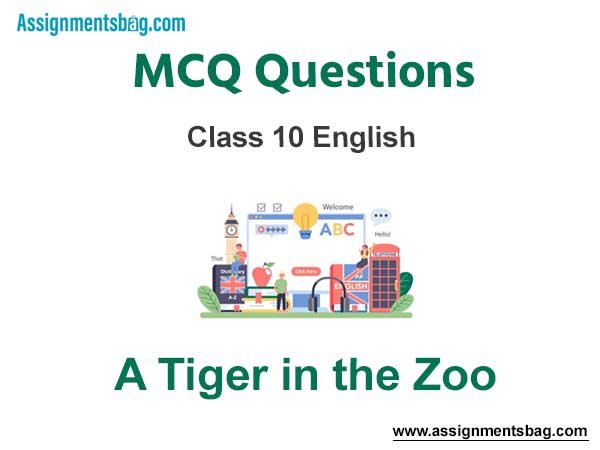Please refer to MCQ Questions Chapter 2 A Tiger in the Zoo Class 10 English with answers provided below. These multiple-choice questions have been developed based on the latest NCERT book for class 10 English issued for the current academic year. We have provided MCQ Questions for Class 10 English for all chapters on our website. Students should learn the objective based questions for Chapter 2 A Tiger in the Zoo in Class 10 English provided below to get more marks in exams.
Chapter 2 A Tiger in the Zoo MCQ Questions
Please refer to the following Chapter 2 A Tiger in the Zoo MCQ Questions Class 10 English with solutions for all important topics in the chapter.
MCQ Questions Answers for Chapter 2 A Tiger in the Zoo Class 10 English
Question. Name the poetic device used in the line “In his quiet rage”.
(a) metaphor
(b) assonance
(c) Oxymoron
(d) Consonance
Answer
C
Question. Snarling means –
(a) Buzzing sound in the jungle
(b) Sound to make afraid the animals
(c) Sound in the water bodies
(d) Sound made by animal
Answer
D
Question. What describes “tiger in a cell”?
(a) Locked in concrete cell
(b) snarling around houses
(c) shadow, long grass
(d) baring his white fangs
Answer
A
Question. How does the tiger feel in the cage?
(a) he was in sad mood
(b) he was in happy mood
(c) he was in angry mood
(d) he was in surprised
Answer
C
Question. Who passes near the water hole?
(a) Fat Pig
(b) Fat Buffalo
(c) Fat Deer
(d) All of the Above
Answer
C
Question. At night the tiger imprisoned could only do of –
(a) Moving inside the cage
(b) Grambling
(c) Eating his stored food
(d) Staring the stars
Answer
D
Question. The tiger has velvet like –
(a) Paws
(b) Nose
(c) Body
(d) Hair
Answer
A
Question. A tiger Is happy when _____.
(a) he is in the cage
(b) he is near the cage
(c) he frightens the visitors
(d) he is free in the forest
Answer
D
Question. How does the caged tiger react to the visitors?
(a) He ignores them
(b) With a happy face
(c) With a sad face
(d) Proudly
Answer
A
Question. The tiger is angry because he –
(a) is hungry
(b) is ill
(c) is bitten
(d) is imprisoned
Answer
D
But he’s locked in a concrete cell, His strength behind bars,
Stalking the length of his cage, Ignoring visitors.
He hears the last voice at night, The patrolling cars,
And stares with his brilliant eyes At the brilliant stars
Question. The fact that the tiger is ‘stalking the length of his cage’ tells us that he is
(a) restless
(b) reckless
(c) resilient
(d) reverent
Answer
A
Question. The tiger’s ‘brilliant eyes’ reveal that he
(a) hopes to be free and in the wild, someday
(b) is looked after well and is nourished and healthy
(c) enjoys staring at the bright stars each night
(d) is well-rested and hence, wide-awake
Answer
A
Question. What is the rhyme scheme of the given stanzas?
(a) abcb; abcb
(b) abcb; abcd
(c) abcd; abcd
(d) abcd; abcb
Answer
D
Question. What is the caged tiger NOT likely to say to the visitors?
(a) “Stop staring”
(b) “Set me free”
(c) “Join me”
(d) “Go away”
Answer
C
Question. These stanzas bring out the contrast between
(a) zoos and cities
(b) strength and weakness
(c) freedom and captivity
(d) visitors and patrolling cars
Answer
C
He should be lurking in shadow,
Sliding through long grass,
Near the water hole,
Where plump deer pass.
Question. Give the antonym of the word ‘lurking’.
(a) hide
(b) sneak
(c) expose
(d) loiter
Answer
C
Question. What is the rhyme scheme of the given stanza?
(a) aabc
(b) abcb
(c) abbc
(d) abac
Answer
B
Question. Name the poet of the poem.
(a) Robert Frost
(b) Leslie Norris
(c) William Wordsworth
(d) John Keats
Answer
B
Question. How does a tiger feel in his natural habitat?
(a) Free
(b) Angry
(c) Ashamed
(d) Frustrated
Answer
A
Question. Why should he be lurking in shadow?
(a) out of fear
(b) out of anger
(c) to catch the deer
(d) Both (a) and (b)
Answer
C


